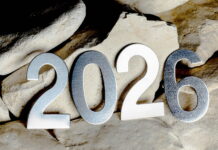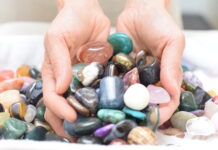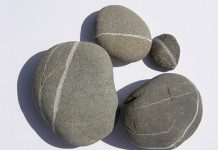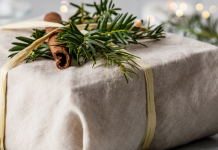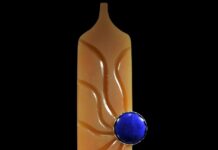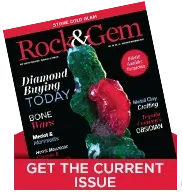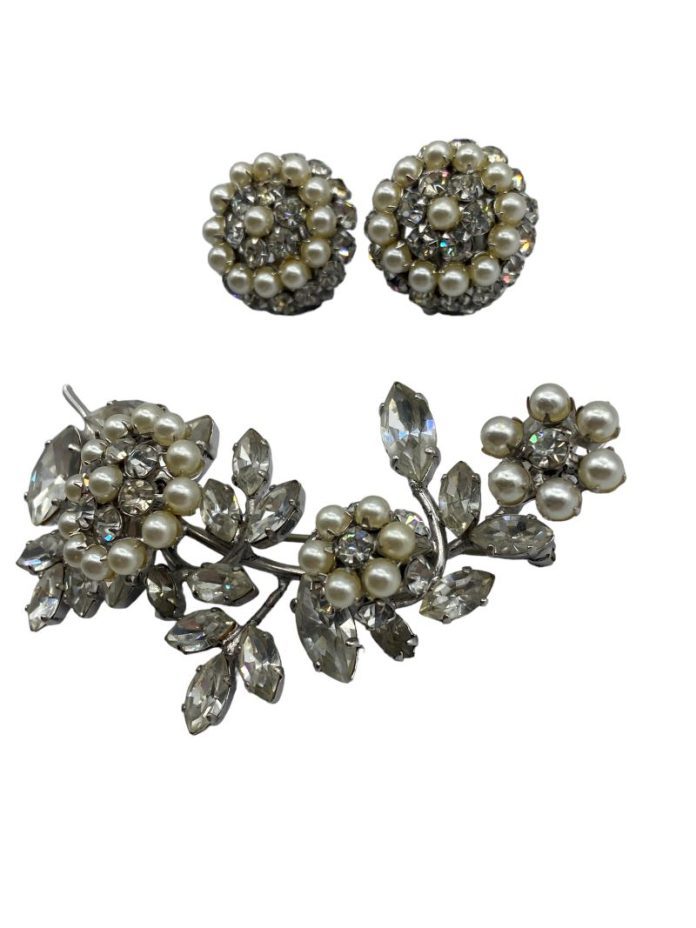
Vintage costume jewelry has a unique history of fabricated jewels for cost-effective and trendy pieces. Find out how it was made and what it’s worth today.
Keeping the Jewelry Safe
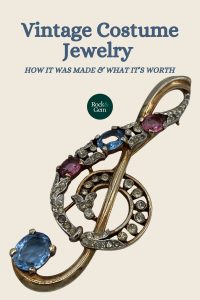
Just before Hurricane Ian leveled her Fort Myers, Florida home, Sheran Behling Little packed away her extensive cache of vintage costume jewelry and stowed it safely against the storm.
“I have earrings, brooches and necklaces that all came to me when my father worked for Napier for about 10 years in the 1970s,” Little recalls. “And I still wear it all and get compliments on it all.”
What’s Old is New Again
Once a way to keep little girls quiet on rainy afternoons, sifting through box after box of inherited, generally inexpensive, so-called costume jewelry has become a pursuit for anyone of any age who wants to pin on, clip on or otherwise recapture a piece of yesterday’s elegance through what used to be called junk jewelry.
In the process, the pieces have caught the eyes of collectors who appreciate their beauty and history even if they don’t have sentimental connections to them.
“People of all ages, educational and social backgrounds collect costume jewelry,” says Melinda Lewis, who with Pamela Siegel established Costume Jewelry Collectors International, a network of costume jewelry aficionados who connect online via social media and at conventions throughout the United States. “My analogy would be that collecting costume jewelry has a shared love language understood by all fascinated by it – the study never gets old.”
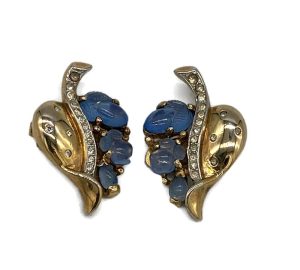
Vintage Costume Jewelry: History Attracts
In fact, it’s history that attracts would-be collectors to costume jewelry in the first place. After that, potential value makes those once so-called throw-away trinkets even more attractive.
Back in the 1920s, flappers began wearing inexpensive, mass-produced, ornate brooches, earrings, fingerings, bracelets and necklaces to add sparkle to the “costumes” or coordinated skirt, blouse and jacket outfits that they wore to their newly acquired jobs in Chicago or New York. On nights out, they wore even more ornate pieces to make them look like the sirens they saw on the movie screen or the well-heeled citified ladies who could actually afford to be dripping in diamonds.
During the Depression of the 1930s, faux jewels reminded women that they could still afford a little glamor, even if their purse strings were becoming more and more frayed.
Making Vintage Costume Jewelry Gems
In these so-called costume pieces, simulated pearls, gemstones made of colorful glass and rhinestones stood in for genuine diamonds, rubies and other precious and semi-precious gemstones, and were either glued or “set” most frequently into a tin base metal mounting.
To fabricate the simulated stones, manufacturers used glass – silicon dioxide (SiO2) – and added a variety of metals and minerals. They mixed selenium and cadmium sulfide to make something called Selenium Rudy and combined this glass material with cobalt to create a rich blue color that mimicked sapphire. Combined with nickel in certain concentrations, the colorless glass material took on a violet hue reminiscent of amethyst.
Their craftsmen then shaped and faceted the “stones” into the gems that starred in costume brooches, necklaces and earrings.
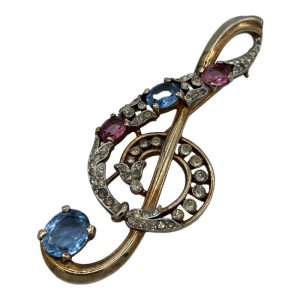
Rhinestone Beauty
The rhinestones used in costume jewelry originated as rock crystals derived from the Rhine River and other locations in the Alps nearby. Eventually, an 18th-century jeweler coated the bottom sides of glass shards with lead to create so-called imitation diamonds. Later, manufacturers substituted the lead backing with a paper-thin covering of foil.
Later, Swarovski crystals joined the costume jeweler’s toolbox to add a deeper, more diamond-like look and more light refraction to the pieces they created.
By the 1940s, the war effort made tin off limits to any manufacturer who was not making anything for military use. As a result, costume jewelry makers placed simulated stones, either faceted or as a cabochon, into silver settings. After the war, nickel, pewter or brass took over to make mountings for costume jewelry.
More recently mass manufactured costume jewelry has been made by using silver or gold plated brass or vermeil – sterling silver over the top of which a coating of gold has been applied – mounting set with simulated stones such as ruby and sapphire.
By the 1970s cubic zirconia (CZs) replaced rhinestones in modern designs and the cost of costume jewelry rose from a few dollars to $50 or more depending on the piece.
Signature Makes
Just how each piece was made was determined by the technique used by the individual manufacturer, Lewis says.
“Costume jewelry is generally characterized by using non-precious metals, glass, rhinestones or plastics. Techniques could include die-struck pieces, hand-manipulated pieces, cast and soldered,” Lewis explains. “The method often was determined by the design or a manufacturer’s specialty.”
According to Jen Avalos, who sells vintage jewelry pieces to clients nationwide through her online stores on Etsy and Whatnot, costume jewelry enjoyed its heyday in the 1950s and 1960s when working women and stay-at-home housewives bought matching earring, necklace and sometimes bracelet sets to complement their workday or special occasion outfits.
At the department store jewelry counter, these sets could cost upwards of $25 dollars depending on the manufacturer, she says. “In fact, items made in the 1950s are generally of better quality than those made in the 1980s,” she says.
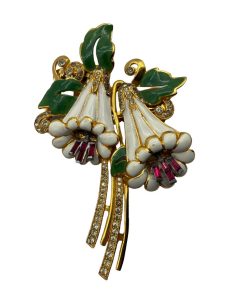
All images courtesy Melinda L. Lewis
Top Jewelry Makers
At the time, manufacturers Trifari, Monet and Napier led the costume jewelry market boosted by full-page, glossy advertising campaigns strategically placed in nearly every magazine aimed at women.
They also each became known for their selections. Trifari was known for elaborate designs and the use of faux pearls. Monet was known for nature-inspired charms for bracelets and necklaces and Napier was known for its use of enamel and abstract-shaped metal. At the same time, they morphed into a specialized segment of the fashion industry by introducing their newest pieces of jewelry at the same time fashion magazines and department stores started to show clothing lines for spring, summer, winter and fall.
“I remember that at least as far as Napier was concerned, new pieces were released when seasonal lines showed up in stores,” recalls Little who worked her way through college in the Napier factory attic where retired designs were kept.
Also according to Little, every season, Napier released a trio of costume jewelry sets that covered every market segment and represented every price range.
“They used to put out three different sets – one that was just ‘okay,’ another that was ‘average’ and the last one that was super good,” she recalls. “That way, the customer didn’t really have to make a choice – it was obvious – so people didn’t have to look at 15 (other) things or any other manufacturers.”
Costume Jewelry Today
These days, collectors continue to seek out vintage necklaces, earring and bracelet sets, as well as pins and brooches to match their “costumes.”
“For example, I have a small guitar pin, about two inches, with bits of glass in it that I still wear,” Little recalls.
Beyond personal ornamentation, costume jewelry is sought by crafters who use it not only to create their own jewelry designs, but also to embellish everything from Christmas tree ornaments and seasonal front door wreaths to bookmarks and lamp shades.
For Sheran Little though, her cache of Napier costume jewelry is going to stay right where it is – in her jewelry box or around her neck, on her wrist or pinned to her blouse.
“Every time I wear it, I think of my mother and my father or some event that took place in my life,” she says. “I just can’t get rid of it.”
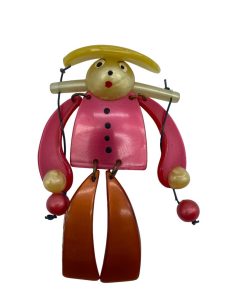
Filling Your Vintage Costume Jewelry Box
An inherited box of Aunt Rose’s vintage costume jewelry is usually the way collectors get their start, according to Avalos. But knowing which pieces are worth keeping and which are not is the first step to building a collection, she says.
“You start by sifting through it,” Avalos advises. “Then look for age, quality and of course, condition.”
To Start…
Make sure earrings and necklaces that were sold in sets remain as intact sets, and weed out pieces that are missing stones or some other crucial design element such as an earring clip, necklace or bracelet fastener, or that otherwise show obvious signs of wear.
Then Notice Age…
Because of their age, pieces that were made in the 1930s are generally more valuable so long as they are intact and do not show obvious signs of wear.
Look for Quality…
“Quality is important,” Avalos says. “If you’re looking for vintage costume jewelry pieces that are going to appreciate, the value of quality pieces tends to go up.”
Seek a Maker’s Mark…
Some manufacturers such as Trifari either stamped their prices or affixed a small logo to each one such as the Trifari “T.” Knowing which of the major manufacturers created the piece can affect how valuable it may be in the wider marketplace.
Be Choosy…
According to Melinda Lewis, some collectors seek pieces featuring animals or holiday motifs. Others collect only brooches or bracelets or earrings.
“That’s what makes the collecting (community) so much fun,” she says.
Make a Love Match…
Just like any other collectible, the market value of vintage costume jewelry fluctuates, so don’t keep or acquire costume pieces with the intent to cash in on them later. Base collections on what is personally appealing, not on the supposed current or future value of each piece.
Then Flaunt It…
“I wouldn’t purchase (or keep) anything as an ‘investment’ piece,” Lewis says. “If you love it, wear it, is my motto.”
This story about vintage costume jewelry previously appeared in Rock & Gem magazine. Click here to subscribe. Story and pictures by Pat Raia.


